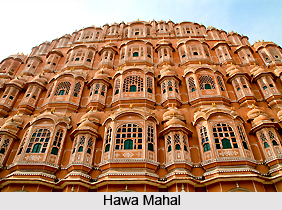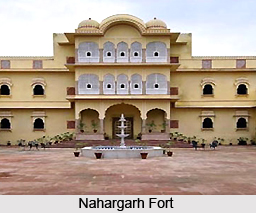 Plaited with the delightful romance of the sepia luster of Thar and with the promises of the Rajput valor Rajasthan is the best place to rediscover the pulse of India so very eloquently. For a leisure trip therefore Rajasthan is indeed the place to be.
Plaited with the delightful romance of the sepia luster of Thar and with the promises of the Rajput valor Rajasthan is the best place to rediscover the pulse of India so very eloquently. For a leisure trip therefore Rajasthan is indeed the place to be.
Jaipur was built in 1728 by Maharaja Sawai Jai Singh II. One of the major attractions here is the City Palace, a part of which remains the residence of the Jaipur family. It is definitely worth a visit. Several gateways lead from the crowded streets into the palace, but it is better to enter it through the main entrance, through the courts of justice to the Jantar Mantar. The construction and precision of the observatory were a unique achievement for the year 1716.
The City Palace Museum, named after Raja Man Singh, is a treat, no matter what the interests of the visitor are -textiles, arms, carpets, paintings, manuscripts. It houses two large urns, possibly the largest silver vessels in India, which were used by Maharaja Madho Singh to carry a six-month supply of holy Ganga water to the coronation of King Edward VII in London.
Hawa Mahal or Palace of Winds is actually no palace but an extraordinary facade of 953 airy windows used by the ladies of the palace to watch the outside world without being watched.
There are several wondrous forts that adorn the landscape of Rajasthan. One of the most interesting forts here is that of Chittorgarh. Tales of courage, sacrifice and romance are embedded within the fort walls. Till date Chittorgarh is famous for its brave heart Queen Padmini.
Amber was once the capital of the Mina tribes believed to be the original inhabitants of this area. Now, painted elephants take visitors up the hill to admire the massive gateways, courts, stairways and pillared pavilions and palaces that recall the glory and wealth of Amber`s association with the Mughals. Raja Man Singh was the Commander-in-Chief of Akbar`s army and Mirza Raja Jai Singh was a powerful ally of Jahangir. The Sheesh Mahal or the Palace of Mirrors has its walls inlaid with exquisite mirrored motifs that dance to the flame of a single candle.
Nahargarh Fort provides a marvelous view of Jaipur city and, en route, of the Jal Mahal. The cenotaphs of the Jaipur maharajas at Amber and Gaitor as well as the chhatris of the maharanis are well worth a visit.
8 kilometers down the Jaipur-Agra road is the charming garden of the Sisodia queen and 2 km further are the holy springs of Galta. Here one would come across temples that have a large daily attendance. The Hanuman Temple, in particular, is worth visiting on Tuesdays.
 Another important tourist destination is Alwar which is picturesque and dotted with historical sites. At Bairath or Viratnagar ancient Buddhist rock edicts of Emperor Ashoka, a Buddhist chaitya dating back to the 3rd century BC and a painted garden pavilion which was built around 1600 AD are the major attractions.
Another important tourist destination is Alwar which is picturesque and dotted with historical sites. At Bairath or Viratnagar ancient Buddhist rock edicts of Emperor Ashoka, a Buddhist chaitya dating back to the 3rd century BC and a painted garden pavilion which was built around 1600 AD are the major attractions.
From Alwar the travelers can move onto the Sariska Palace. Once upon a time this was a hunting lodge but now it has been converted into a private hotel set on the outskirts of a wildlife sanctuary where tiger, panther, blue bull, wild boar and deer roam the scrubby thicket and bush. The charming Siliserh Palace also lies nearby. It commands a wonderful view of a lake full of water fowl. This is a Rajasthan state hotel.
The Alwar Museum has a fine collection of miniature paintings, manuscripts, arms and the famous solid-silver dining table. Adjacent to the museum is a remarkable reservoir with delicate temples, kiosks and symmetrical stairs considered masterpieces of Indo-Islamic architecture.
Other places of interest in Rajasthan comprise of Shekhavati and Churu. These painted towns are worth checking out for their havelis. in fact the havelis of Shekhawati are quite popular with the travelers.The wealthy merchants of this region had built palatial havelis, cenotaphs in memory of their ancestors, and reservoirs, temples and caravanserais for the people. the buildings are mostly covered with frescos painted between 1760 and 1920 AD. The havelis were fortified houses which walled in the secluded life of the women who spent most of their days in the zenana. These were built around an inner courtyard. The men conducted their business on the white cotton mattresses of their sitting rooms.
On the other hand the streets of Nawalgarh are lined with the richly painted facades of havelis and the market bustles with activity. A garden palace on the outskirts is a popular jaunt. From Nawalgarh the road leads on to Dundlod and Mandawa, the rugged forts of which are now well-stocked hotels with a rare medieval charm. Fatehpur too offers a wealth of painted havelis.
Bikaner was founded in the year 1488. A younger but more intelligent son, Rao Bika, was given an army and asked to seek his own fortune to avoid a war of succession. Thus Bikaner was founded in heart of the wilderness called Jangaldesh. The red sandstone carvings at the Lalbagh Palace and those in marble are among the finest in delicacy and profusion; the fortress, built in 15th century, contains palaces and temples of great refinement. This place is also famous for its miniature painting. The Hall of Audience has breathtaking frescos, gilded stucco mouldings, floral patterns, and incredibly delicate carpets. The outskirt of Bikaner is worth checking out because of the camel farm. it will be interesting to visit it particularly at sunset when herds of camels return from the dunes.
Kishangarh, too, is an interesting city of palaces and lakes. The City Palace, the Phool Mahal and the Kalyan Raiji Temple are beautifully located by the side of a lake. The largest collection of paintings of the renowned Kishangarh School is to be found at the Majhela Palace. However, prior appointment is necessary to view these paintings.
From here the travelers can move onto the marble cenotaph at Karkeri, the Krishna Temple of the Nimbarkachari sect at Salemabad, and the fort and palace of Rupangarh. A little further away, the salt lake of Sambhar is a unique sight along with the marble quarries at Makrana.
Around 80 kilometers from Jaipur lies Tonk that was once ruled by the Muslim Nawabs. This city has charming painted mosques and a host of colonial buildings that housed the British resident and his entourage. Of particular interest is the Sunehri Kothi or golden mansion. A fairly small and simple structure from the outside, its interior is studded like a jewel box. An inlay of coloured glass, mirrors, gilded stucco and strappings, painted and polished lime floors, stained window panes, add up to an amazing sumptuousness.



















